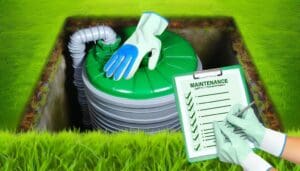Discover how to protect your septic system from breakdown with...
Read MoreYou & Your Septic Tank
The Ultimate Guide To Maintaining Your Septic Tank Between Pumpings
Our professional septic service team offers comprehensive septic tank pumping services to keep your system running smoothly. Get a FREE Quote Today.

The Ultimate Guide To Maintaining Your Septic Tank Between Pumpings
Ah, the septic tank. It’s one of those things we don’t usually think about until something goes wrong – and when it does, it can really stink (literally).
But did you know that with a little TLC between pumpings, your trusty septic system could provide you with years of hassle-free service? That’s right; just like any other part of your home, taking care of your septic tank is all about being proactive.
As an expert in the field, I’m here to share my tips and tricks for maintaining your septic tank so that you can avoid unpleasant surprises down the road.
In this ultimate guide to septic tank maintenance, I’ll be covering everything from understanding how your system works to knowing when it’s time for a professional inspection or pumping. You might even feel a sense of liberation as you become more familiar with the inner workings of your own wastewater treatment plant!
So let’s dive in (figuratively speaking) and explore what steps you can take today to ensure smooth sailing for both you and your septic system in the future.
Understanding How Your Septic System Works
Hey there, fellow septic tank enthusiast! Let’s dive in and talk about the magic that happens behind the scenes of your home. You see, understanding how your septic system works is key to maintaining it properly between pumpings.
By avoiding clogs and saving water, you can keep everything running smoothly while contributing to a cleaner environment.
So how does your trusty septic tank operate? Well, waste from your household flows into the tank where solids settle at the bottom, forming sludge. Meanwhile, oils and grease rise to the top as scum. The remaining liquid then makes its way out of the tank and into a drain field where it gets filtered through several layers before being absorbed by surrounding soil or evaporating back into the atmosphere—pretty neat stuff!
Now that we’ve got a basic grasp on this fascinating process, let’s delve deeper by identifying different components within our very own underground superhero—the septic system!
Identifying The Different Components
Now that we’ve covered the basics of maintaining your septic tank, let’s take a closer look at the different components within the system. Understanding these parts and their functions will help you better care for them and identify any potential issues before they become problematic. Plus, knowing what to look out for when installing or repairing components can save you time, money, and headaches down the road.
Here are some key elements of your septic system:
- Tank: The primary container where wastewater collects and separates into layers.
- Inlet pipe: Transports waste from your home to the tank
- Outlet pipe: Allows effluent (liquid) to exit the tank and enter the drain field
- Drain field: A series of perforated pipes buried in gravel trenches that disperse treated effluent into surrounding soil.
- Distribution box: Helps distribute effluent evenly throughout the various sections of the drain field
Remember, each component plays an essential role in treating wastewater effectively. By staying vigilant with regular inspections and addressing any concerns as soon as they arise, you’ll be able to extend the life of your septic system considerably.
Next up, we’re going to dive deeper into performing regular preventative maintenance on these various components – keeping everything running smoothly so you can enjoy hassle-free living!
Performing Regular Preventative Maintenance
Think of your septic tank like a marathon runner. To keep it in peak condition, you need to perform regular preventative maintenance – that way, when the race is on and the tank needs to put its best foot forward, it’s ready for action!
As a septic tank maintenance expert, I can’t stress enough how important this is. By keeping an eye on testing levels and ensuring optimal absorbing capacity, you’re not only extending the life of your system but also helping protect our environment.
Now let me tell you folks, there are some key aspects to maintaining your septic system between pumpings that will make all the difference. Inspection checks should be carried out at least once a year to monitor sludge buildup and ensure the proper functioning of mechanical components. Investing time into these routine checkups ultimately saves you from costly repairs down the line while providing peace of mind knowing that everything is running smoothly beneath your feet.
So with those essential practices under our belts, let’s delve deeper into one crucial aspect of proper septic care: properly disposing of household waste.
Properly Disposing Of Household Waste
Hey there, I’m here to talk to you about properly disposing of household waste and maintaining your septic tank between pumpings. The three main subtopics I want to discuss are avoiding disposal of grease, separating food waste, and avoiding flushable wipes. First, it’s important to avoid disposing of grease down the drain, as it can clog and damage your septic tank. Second, it’s a good practice to separate food waste from other items and dispose of it in the trash. Lastly, be sure to avoid flushable wipes as they can cause a major issue for your septic tank.
Avoiding Disposal Of Grease
We’ve all been there, standing over the kitchen sink with a pan full of cooking oils and grease. It’s tempting to pour it down the drain, but trust me as your septic tank maintenance expert, doing so can lead to disastrous consequences for your septic system.
When fats, oils, and grease make their way into your plumbing, they solidify and cause blockages that could require costly repairs in the long run. Furthermore, harsh cleaning chemicals can disrupt the natural balance within your tank by killing off essential bacteria needed for breaking down waste material.
So let’s all make an effort to properly dispose of these substances – whether it’s recycling used cooking oil or safely containing chemical products before disposal – because giving our septic tanks some TLC now means freedom from unexpected headaches later on!
Separating Food Waste
Now that we’ve got a handle on avoiding fats, oils, and grease going down the drain, let’s talk about another crucial aspect of keeping our septic systems in tip-top shape: separating food waste.
I know it’s easy to just chuck everything into the garbage disposal or trash can, but trust me, being more mindful about reducing waste will do wonders for your septic tank.
Start by setting up a compost bin for fruit and vegetable scraps – not only does this save space in your tank, but it also creates nutrient-rich soil for your garden!
Another handy trick is installing sink strainers to catch any remaining solids before they make their way into your pipes.
So come on, folks – let’s give ourselves the freedom from clogged drains and expensive repairs by taking these simple steps towards responsible household waste management!
Avoiding Flushable Wipes
Now that we’re getting the hang of separating food waste, let’s tackle another common culprit of septic system issues: flushable wipes.
Despite their name, these seemingly harmless items can create major problems for your tank – and I know you don’t want to deal with those consequences of misuse!
As a septic tank maintenance expert, I highly recommend avoiding chemicals and products like these so-called ‘flushable’ wipes.
Instead, stick to good ol’ toilet paper or invest in a bidet attachment to keep things flowing smoothly without any extra stress on your system.
Trust me; embracing this simple change will set you free from potential plumbing disasters and help preserve the longevity of your septic system!
Monitoring Your System’s Performance
Now that we have a solid grasp on properly disposing of household waste, let’s move to another critical aspect of septic tank maintenance: monitoring your system’s performance.
Staying vigilant about how well your system is functioning can help you avoid costly repairs and ensure the longevity of your system. Plus, it will give you peace of mind knowing that everything is working as it should.
One crucial part of monitoring your septic tank involves testing levels and water flow within the system. By keeping an eye on these factors, you’ll be able to detect any potential issues before they become significant problems.
Regularly checking for changes in water flow patterns or unusual odors coming from drains can also serve as essential indicators that something may not be right with your septic system. Remember, staying proactive when it comes to maintaining your septic tank translates into more freedom from worry and unexpected expenses down the road!
With all this information at hand, let’s now discuss the importance of recognizing when it might be time to call in professional help.
Knowing When To Call A Professional
Checking your septic tank levels is key to making sure your tank is functioning properly. You should look out for any warning signs, like frequent backups or slow drains, that may indicate you’re due for a pumping. To ensure your septic system is always in tip-top shape, it’s important to schedule regular maintenance with a professional.
Checking Tank Levels
I’ve got to tell you, there’s something liberating about being in control of your septic tank maintenance. Especially when it comes to checking those tank levels!
As a seasoned expert, I know that evaluating risk and monitoring trends are crucial steps in maintaining your system between pumpings.
By regularly inspecting the fluid level inside the tank, you can gauge if it’s time for a professional intervention or if everything is running smoothly as it should be.
Remember, this isn’t just about saving money on unnecessary services – it’s also about ensuring the longevity of your septic system and preserving our precious environment.
So go ahead, embrace that inner eco-warrior spirit and take charge of your septic tank like a pro!
Understanding Warning Signs
Now that you’re embracing your inner septic tank warrior, it’s essential to recognize when it’s time for reinforcements. Understanding warning signs is a critical part of knowing when to call in the professionals.
Keep an eye (and nose) out for odor detection around your property – this could be a sign of trouble brewing! Additionally, pay close attention to any water discoloration coming from your faucets or pooling on the ground near the drain field.
These indicators can help you determine if there’s an issue with your septic system requiring expert assistance. Trust me, striking a balance between DIY maintenance and calling in pros when needed will not only liberate you but also ensure the health of both your system and our environment!
Scheduling Regular Maintenance
Now that we’ve talked about recognizing warning signs, let’s discuss another crucial aspect of knowing when to call a professional – scheduling regular maintenance.
You see, my fellow septic tank warriors, keeping up with routine check-ups is just as important as addressing those telltale issues we mentioned earlier.
By storing records of your system design and past services, you can keep track of when it’s time for the next inspection or pumping session.
Regular maintenance not only extends the life of your septic system but also keeps our environment protected by preventing potential leaks and contaminations.
Together, let’s strive towards liberation from septic troubles while ensuring the harmony between our homes and Mother Earth!
Scheduling Regular Inspections And Pumpings
Savvy septic system owners, step right up! Scheduling regular inspections and pumpings is a pivotal part of keeping your tank in tip-top condition. You might be wondering how often you should have these appointments – well, let me help guide you through the process. As an expert in septic tank maintenance, I can assure you that having a proper schedule for these tasks will not only keep your tank functioning smoothly but also provide you with that liberating sense of peace knowing everything’s under control.
There are some key factors to consider when deciding upon the frequency of inspection and pumping visits:
- Tank Size: Smaller tanks tend to require more frequent pumpings.
- Typical household tanks need service every 3-5 years
- Household Size: More people means more wastewater production.
- A family of four may need their tank pumped every 2-4 years
Aside from staying on top of inspections and pumpings, there are other measures you can take to maintain your septic system between those visits. For instance, using additives judiciously can aid in breaking down waste materials while avoiding overloads by being mindful of water usage ensures the smooth operation of your system. This kind of proactive approach not only keeps potential issues at bay but also contributes towards achieving that subconscious desire for liberation we all crave.
Now that we’ve covered scheduling regular inspections and pumpings, our next topic delves into understanding the impact soaps and detergents can have on your septic system’s health.
Understanding The Impact Of Soaps And Detergents
You might be wondering, what’s the big deal about soaps and detergents when it comes to maintaining our septic tanks? Well, let me tell you – using eco-friendly products and properly diluting detergents can make a huge difference in how well your septic system functions.
Traditional cleaning products often contain harsh chemicals that can disrupt the delicate balance of bacteria within your tank, leading to potential problems down the line.
Now don’t worry, I’m not saying you need to give up cleanliness altogether! There are plenty of options available for those of us who want to keep our homes spick-and-span while still being mindful of our impact on the environment (and our septic systems).
By making simple changes like switching to biodegradable soaps or opting for plant-based cleaners, you’re taking steps towards liberation from harmful chemicals and ensuring a healthier septic system. As we continue exploring this topic further, let’s dive into some natural alternatives that will help prevent damage to your precious underground asset.
Using Natural Alternatives To Avoid Septic System Damage
Now that we’ve covered the basics of maintaining your septic tank, let’s dive into some natural alternatives to help avoid septic system damage. After all, who wouldn’t want a more environmentally friendly approach? By reducing water usage and harnessing rainwater, you’re not only saving money on your water bills but also ensuring that your septic tank stays in tip-top shape for longer periods.
Here are three easy-to-implement tips for using natural alternatives to keep your septic system healthy:
- Reduce Water Usage: A little goes a long way when it comes to conserving water.
- Install low-flow fixtures such as faucets, showerheads, and toilets
- Fix any leaks promptly – even small drips can add up over time
- Use a broom instead of a hose to clean driveways and sidewalks
- Harness Rainwater: Collecting and utilizing rainwater is an excellent method for preserving our precious resources while easing the workload on your septic system.
- Install rain barrels or cisterns to capture runoff from roofs
- Use collected rainwater for landscaping purposes like watering plants or washing outdoor furniture
- Implement permeable surfaces (e.g., gravel walkways) around your property to allow rainfall infiltration and reduce runoff
- Choose Eco-Friendly Cleaning Products: Harsh chemicals can wreak havoc on both your septic system and the environment; opt for greener options instead.
- Select biodegradable soaps and detergents free of phosphates or bleach
- Avoid chemical drain cleaners – use enzyme-based products or try DIY remedies like baking soda and vinegar
- Dispose of hazardous waste properly at designated collection sites
As we embrace these sustainable practices, it’s essential to remember that life happens, and unexpected issues may still arise. Let’s move forward by discussing how best to plan for those worst-case scenarios involving your septic system.
Planning For Worst-Case Scenarios
Picture this: your in-laws are visiting for the weekend, and suddenly you’re faced with a septic tank disaster. The unpleasant smell is unbearable, there’s water pooling in your yard – it’s every homeowner’s nightmare!
But don’t worry; I’ve got you covered. By preparing backups and avoiding overflows, we can keep these worst-case scenarios at bay.
One of the most effective ways to prepare for such emergencies is by having an extra drain field on hand as a backup plan. This way, if something goes wrong with your primary drain field during peak usage times (like when hosting guests), you’ll be ready to switch systems temporarily until you have time to address the issue properly.
Another essential step is regularly monitoring your system’s performance and ensuring that all components are functioning optimally. Keep an eye out for any signs of leaks or blockages so they can be promptly addressed before developing into full-blown disasters.
Remember, by being proactive about maintaining our septic tank systems, we not only avoid frustrating situations but also grant ourselves the liberation from worrying about unexpected problems down the line.
Frequently Asked Questions
How Can I Safely Landscape Around My Septic Tank Without Causing Damage To The System Or Interfering With Its Function?
I know what you’re thinking: how can I safely landscape around my septic tank without causing damage to the system or interfering with its function? Well, I’ve got your back! As a septic tank maintenance expert, let me share some insider tips that’ll have your yard looking fabulous while keeping everything running smoothly.
First off, it’s crucial to use waterproofing techniques when landscaping near your tank; this helps protect the integrity of the system and ensures proper drainage.
You might also want to consider soil testing before diving into any major projects – trust me, knowing the type of soil you’re working with will save you loads of trouble down the line.
And remember, as tempting as it may be to create an elaborate garden oasis around your septic tank, less is often more in these situations. By sticking to low-maintenance plants and lightweight materials for hardscaping, you’ll minimize the risk of damaging your beloved system while still achieving that backyard paradise vibe we all crave.
Are There Any Warning Signs That My Septic Tank May Be Nearing Capacity Or Experiencing Issues, Even If It Is Not Yet Time For A Scheduled Pumping?
Did you know that nearly one in five U.S. homes rely on septic systems to treat their wastewater?
As a septic tank maintenance expert, I can’t stress enough the importance of regularly inspecting your system for signs of trouble even if it’s not time for a scheduled pumping.
Keep an eye out for warning signs like slow-draining sinks and toilets, unpleasant odors near the drain field, or unusually lush vegetation around the tank area – these could indicate that your septic tank is nearing capacity or experiencing issues.
By staying proactive and addressing any risks associated with an overburdened system, you’ll be able to enjoy the freedom and peace of mind that comes from knowing your home’s waste management is functioning optimally!
How Do Seasonal Changes, Such As Heavy Rain Or Freezing Temperatures, Affect The Performance Of My Septic System And What Precautions Should I Take?
Seasonal changes can certainly impact your septic system’s performance, so it’s essential to be proactive and take necessary precautions.
During heavy rainfalls, waterproofing your tank is crucial to prevent excess water from infiltrating the system and causing issues like overflowing or reduced efficiency.
On the other hand, freezing temperatures can lead to frozen pipes and potential damage if not adequately insulated.
To ensure optimal functioning throughout the year, you should also consider regular soil testing around your drain field, as this helps identify any imbalances or saturation problems that may arise due to weather fluctuations.
By staying vigilant and adapting to seasonal changes, you’ll enjoy a well-functioning septic system that grants you peace of mind and liberation from costly repairs down the road.
Can I Use My Garbage Disposal With A Septic System, And If So, What Types Of Food Waste Should I Avoid Putting Down The Disposal?
Navigating the world of garbage disposals and septic systems can feel like walking a tightrope, but don’t worry, I’m here to guide you through it.
Yes, you can use your garbage disposal with a septic system; however, it’s essential to be mindful of what types of food waste you’re grinding up in there.
Grinding scraps such as grease, oils, fats, coffee grounds or fibrous foods (think celery or corn husks) should be avoided as they can cause damage to your septic system.
Additionally, steer clear of using harsh drain cleaners which could disrupt the delicate balance within your tank.
By being conscientious about what goes down your disposal, you’ll not only keep your septic system running smoothly for longer but also experience that liberating feeling of knowing you’re doing right by your home and our shared environment.
What Should I Do If I Accidentally Flush Something That Is Not Septic-Safe, Such As A Non-Biodegradable Item Or A Large Amount Of Grease, Down The Drain?
Oops, we’ve all been there – accidentally flushing something that isn’t septic-safe down the drain. Don’t panic! The key to dealing with this situation is clog prevention and regular inspection.
First off, try to remove the item if it’s still within reach or visible in your plumbing system. If you can’t retrieve it yourself, call a professional for help before it causes any issues.
In cases where grease has been poured down the drain, pour boiling water mixed with vinegar and baking soda to break up the grease and clear the pipes.
Make sure you keep an eye on your septic system by scheduling routine inspections (at least once every 3 years) so that experts can assess any potential damage caused by non-biodegradable items or grease buildup.
By staying proactive and vigilant about what goes into your drains, you’ll be able to enjoy a smoothly running septic system without worrying about unexpected surprises!
Conclusion
In conclusion, maintaining the harmony between your landscaping endeavors and septic system can seem like a delicate dance. However, with thoughtful planning and vigilance, you can create a beautiful yard while ensuring your septic tank remains in tip-top shape. Just remember to keep an eye out for any warning signs of potential issues and don’t hesitate to reach out to professionals when needed.
As seasons change, so do our responsibilities as homeowners – after all, there’s always something new to learn! By understanding how different weather conditions may affect our septic systems and taking appropriate precautions, we become better stewards of our homes and the environment.
There’s no denying that knowledge truly is power – or should I say ‘pumping’ power? And lastly, let us embrace the beauty of balance by using our garbage disposals responsibly. It’s essential to be mindful of what goes down those pipes because even one small slip-up could lead to big problems.
In this grand symphony called life, consider yourself the conductor directing every note played inside your home; give importance even to seemingly minor details such as proper waste disposal habits – it makes all the difference! By following this ultimate guide on maintaining your septic tank between pumpings, you are not only protecting your investment but also contributing positively toward a healthy environment for generations to come.
You may also like...
Why Are DIY Fixes Essential for Septic Tank Pumping?
Tap into the importance of DIY fixes for septic tank...
Read MoreUnveiling the Average Costs of Septic Tank Pumping
Master the mysteries of septic tank pumping costs and avoid...
Read More
The Best Septic Tank Pumping Services Near You

Answer Some Questions
Let us know about your needs so we can find you the right septic tank pros.

Get Quotes
We will put you in touch with the right septic tank pros for your job and location.

Hire Right
Compare quotes, message or call pros, and hire only when ready.



